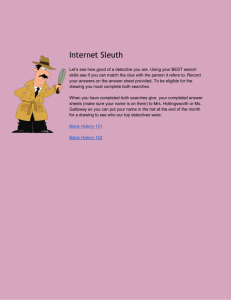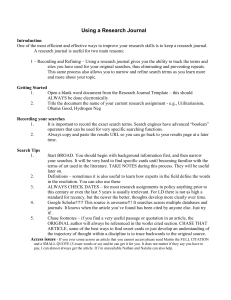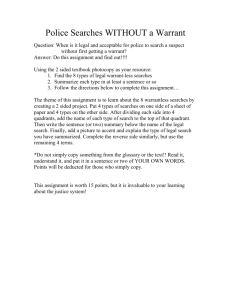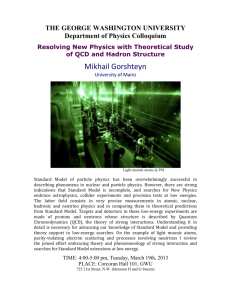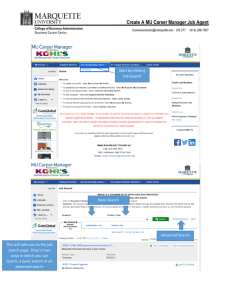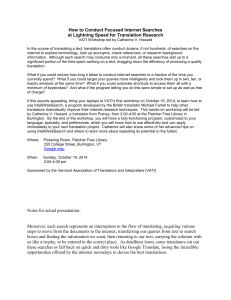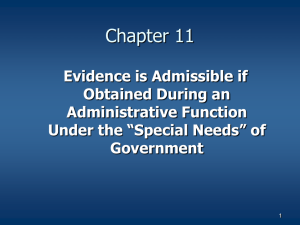File
advertisement
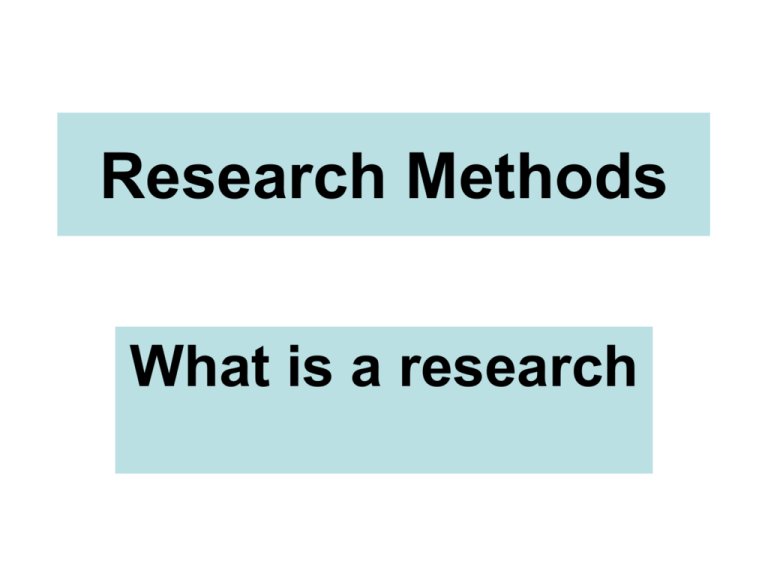
Research Methods What is a research https://faculty.sau.edu.sa/ f.zein f.zein@sau.edu.com Research Methods MLA Handbook for • writers of writers of research papers Gibaldi,Joseph,2009 • Learning outcomes By the end of the course the • students will be able to write research proposals. Learning objectives. • A scientific research • is a systematic way of finding answers to questions. Components of a research Statement of the • problem Research questions • Objectives • Importance • Limitations • Literature review • Research methodology • Data analysis • Conclusion • &recommendations Any well-developed design will achieve the following: 1.Identify the research problem clearly and justify its selection, particularly in relation to any valid alternative designs that could have been used, 2.Review and synethesize previously published literature associated with the problem. 3.Clearly and explicitly specify research questions central to the research problem. Effectively describe the data and explain how such data will be obtained. Describe the methods of analysis to be applied to the data in determining whether or not the questions have been answered. Lecture 2 Learning objectives : to : select a topic, know the research design, take notes. The research paper is exploration Types of research Primary research is the study of • subjects through investigation, such as making a survey, interview,lab experiments. Secondary research includes • examination of studies that other researchers have done. The research paper as a form of communication A research paper should present • information and ideas clearly and effectively. The researcher applies the knowledge and skills that have been acquired through different pervious writing experiences. Different approaches to research writing All writers research papers do • the following: 1.selecting a suitable topic • 2.conducting research • 3.compiling a working • bibliography 4.taking notes. • 5.outlining. • 6.preparing the paper 1.selecting a suitable topic Students submit topics for the instructor for approval early in the research project. Finding a focus : Choice of a topic depends on The allotted time. The length of the research paper Begin with a general topic then make it more specific. Try to narrow your topic by focusing on an aspect of the subject or an approach to it. Examples The general subject: ‘violence in the media’ can be narrowed into : the effect of cartoon violence in preschool children’ Choose one lens through which to view the research problem, or look at just one facet of it . For example: rather than studying the role of food in Eastern religious rituals; study: the role of food in Hindu ceremonies, or, the role of one particular type of food among several religions. Your initial variables or unit of analyses can be broken into smaller parts : For example: tobacco use among adolescents chewing tobacco female adolescents in a certain age range who smoke]. the smaller the area of analysis, the more narrow the focus Example: trade relations in Gulf countries. trade relations between Oman and Kwait. how do two or more different perspectives or variables relate to one another? [e.g., cause/effect, compare/contrast, contemporary/historical, group/individual, male/female, opinion/reason, problem/solution. Task: Select general topics Narrow your topics Home work (individual) Select two general topics and narrow them. Library research sources: Information sources fall into 4 categories: 1.Electronic sources 2.Books and similar publications 3.Articles and other publications in print periodicals such as. journals, newspapers, and magazines Additional sources: Non-print sources like video recordings and unpublished writing. Reference works a.Print : May be located in a reference room. i.General reference books like dictionaries, encyclopedias, biographical sources, yearbooks, atlases ii. Specialized reference books: They are grouped according to subject area-biology, business, literature,. . . b.Electronic Reference works available as electronic databases are usually online or on CDROM OR DVD-ROM Types of reference works: i. reference works that provide data about research materials, like indexes and bibliographies, they are lists of publications usually classified by subjects ii.collections of abstracts Present summaries of journal articles and other literature. Guides to research Guides to research direct you to the most source of information in the area you are searching. B. Reference works that give basic information about subjects: b.1.Dictionaries provides information, usually concise definitions about words or topics. B.2. Encyclopedias give introductory information about subjects. B3.biographical sources describe the lives of prominent persons. B4.year books present facts about years in the past. B5.atlases are collections of maps B.6.Almances Almanacs are annual publications containing data, espicially, statistics about many subjects Lecture3 Searching a reference database Learning Objectives: • 1.To know types of searches for a reference database. 2.To Evaluate sources. In MLA Bibliography is written in two: electronic and print versions. Types of searches -author searches -title searches -subject searches -expanded searches -Boolean searches Author searches By entering the name of a scholar you can obtain a list of the title by the author that are collected in the database. For example: Gibaldi Joseph, Brown Douglass Activity 1 Enter the name of the following authors: 1.Rod Ellis 2.Richards, J.& Schmidt, R 3.McDonough, S. 4.Littlewood 5.W. Krashen, S. Title searches By entering the title of a work you can obtain a complete bibliographic information the work. For example: Applied linguistics in language education Foreign and second language learning Second language acquisition and second language learning. Enter the following titles: 1.Principles of language learning and teaching 2.Social psychological aspects of second language acquisition 3.Attitudes and motivation in second language learning Subject searches Subject searches is accompanied by description, a term that describes the work .For example: language learning Expanded searches You can expand or narrow your searches to get a broad sense of possibilties.If you have a general idea About a topic ‘detective fiction’ you can find a related subjects by entering the word ‘detective’ you can have: Detective drama Detective novel Detective story Boolean searches You send request search by entering and, or, not. For examples:you can use Boolean ‘or’ to expand your search: 3.McDonough, S. Or W. Krashen If you want to perform narrower searches the Boolean ‘not’ and ‘and’ can limit the field of titles accessed. Bibliographic information provided The databases allow you to print out or download bibliographic information. This includes: author name, title,and publication details(year,publication type,. ,language of publication, international standard serial number ISSN, update code, accessed number and sequence number.See figure 2 page19. Evaluating sources It is difficult to evaluate sources. • Not all sources are equally reliable or of equal quality. Some material may be based on incorrect or outdated information poor logic ,and the author or on view or knowledge is biased or too limited. How to evaluate sources? The focus should be on: a.Authority, b.accuracy, and c.currency of the sources. Authority Most scholarly journals and academic book publishers pass through a policy of consultant review by ‘peer review’ and ‘editorial board’. In ‘peer review’ the publishers seek the advice of expert readers or referees before publication. Each consultant read the work and send the publisher a report evaluating the manuscripts, either recommending or not recommending. Readers comment on : The importance of the subject, the originality and soundness of the argument, the accuracy of the facts, and the currency of the research Editorial board An editorial board also reviews the manuscript. Evaluating the authority of an Internet source Considerations: 1.author: The of the author of the work should be identified and the persons responsible for the site. 2.text: Use reliable editions, look at who the editor of the text and when. 3.Editorial policy: Look for statement of mission and purpose and the evidence that the document underwent consultant review(e.g. the lists of an editorial board. 4.Publisher or sponsoring organization: The name of the publisher or sponsoring organization should be clearly stated with access to information about the organization(e.g.www.npr.org b.accuracy Check to see the work sources that appear in the list of works cited. The titles in the list might also tell you about the author knowledge about the subject and about any bias. A web publication might supply hypertexual links to the sources. Note whether there is email address to the author or org. Currency Although online documents and sites have potential for continual updating ,many may be out -of -date. A document should record all dates of publication. the end
